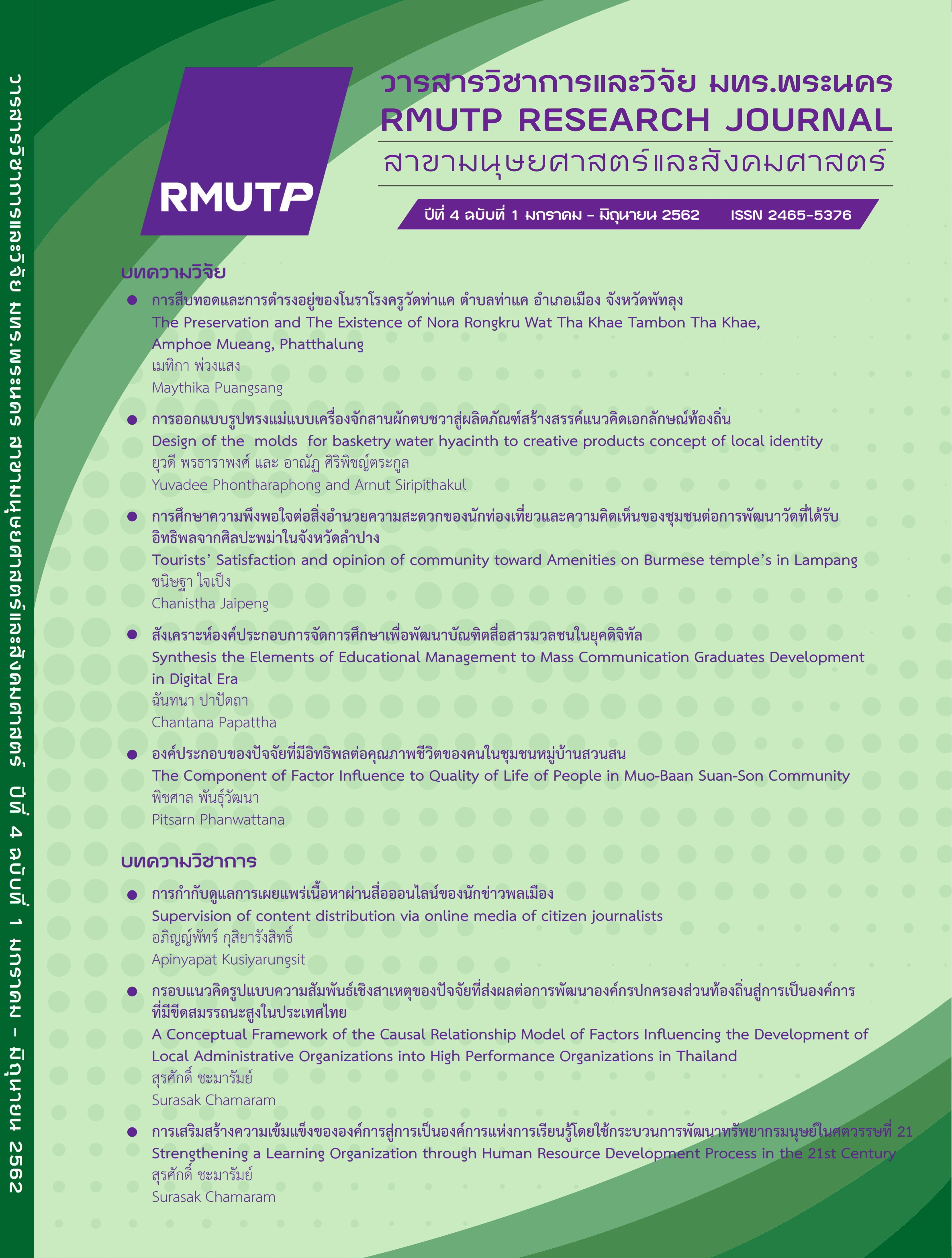Design of the molds for basketry water hyacinth to creative products concept of local identity
Main Article Content
Abstract
The objective of this study 1) To study the shape of the template from the process of making basketry 2)To design a template hyacinth wicker products creative products 3)To experiment with the pattern of woven water hyacinth 4)To create a unique product that is more valuable to the local wisdom and value. How to conduct research The result of the design Creative process Is to collect data. Field Survey and Inquiry Observation of the participation in the process of weaving water hyacinth products to collect information before designing water hyacinth wicker.
The research on the design of water hyacinth wicker template to produce the concept of local identity showed that the shape of the design can be shaped as a creative product is free form, oval form of the circle form which all three forms can be developed to form a product. The most satisfying shape is an independent figure product is a beautiful chair the proportion of products is suitable for use and strong products are local and creative.
The process of water hyacinth wicker requires a template for forming the original material used to make the wicker template is plywood or foam material during the study phase the researcher invented the material for making water hyacinth woven basket template, using rubber water mixed with plastic watercolor foam templates are used for easy handling and longer durability.
Article Details
References
จาก https://www.nmt.or.th/TOTOP/Lists/List33/AllItems.aspx
จำลอง วิบูลย์ปิ่น. (2545). ศิลปหัตถกรรมผักตบชวาในจังหวัดนครปฐม. วิทยานิพนธ์ ศศ.ม.
(ไทยศึกษา). นครปฐม : บัณฑิตวิทยาลัย มหาวิทยาลัยราชภัฏนครปฐม
ธนกรณ์ ศิริสุขโภคา. (2555). การศึกษาวิเคราะห์ผลิตภัณฑ์เครื่องจักสานผักตบชวา กรณีศึกษา ตำบลไทรงาม อำเภอบางเลน จังหวัดนครปฐม.ศิลปนิพนธ์ กศม.(ศิลปศึกษา). กรุงเทพฯ:บัณฑิตวิทยาลัย มหาวิทยาลัยศรีนครินทรวิโรฒ
มะลิฉัตร เอื้ออานันท์. (2545). แนวโน้มศิลปศึกษาร่วมสมัย.กรุงเทพฯ : สำนักพิมพ์ คณะ
ครุศาสตร์ จุฬาลงกรณ์มหาวิทยาลัย
มาตรฐานผลิตภัณฑ์ชุมชน : ผลิตภัณฑ์จากผักตบชวา(มผช. 39/2546). (2558). สืบค้นข้อมูลเมื่อ
วันที่ 23 ก.ค.2558 จากhttps://www.nkw.ac.th/courseware/www.nectec.or.th
มาโนช กงกะนันทน์. (2559). ศิลปะและการออกแบบ.กรุงเทพมหานคร: สำนักพิมพ์โอเอส พริ้นติ้งเฮาส์ จำกัด
มนตรี ยอดบางเตย. (2538). ออกแบบผลิตภัณฑ์.กรุงเทพมหานคร : สำนักพิมพ์โอเอส พริ้นติ้งเฮาส์ จำกัด
ลำเพาะ มะนะ. (2534). ผักตบชวา.กรุงเทพมหานคร : สำนักพิมพ์ อรุณการพิมพ์
วัชรินทร์ จรุงจิตสุนทร. (2548). หลักการและแนวคิดการออกแบบผลิตภัณฑ์.กรงุเทพฯ:แอ๊ปป้า
พริ้นติ้งกรุ๊ป จำกัด.
วิบูลย์ ลี้สุวรรณ. (2546). ศิลปะชาวบ้าน. กรุงเทพฯ : สำนักพิมพ์ อัมรินทร์
. (2532). เครื่องจักสานในประเทศไทย . กรุงเทพฯ : โอเดียนสโตร์
วัฒนา บันเทิงสุข. (2546). การวิจัยเชิงปฏิบัติการณ์แบบมีส่วนร่วมของประชาชนใน กระบวนการถ่ายทอดภูมิปัญญาท้องถิ่นด้านการใช้สมนุไพรในชุมชนบ้านซากตับเต่า จังหวัดระยอง. วิทยานิพนธ์ กศ.ด.(การบริหารการศึกษา) กรุงเทพฯ : บัณฑิตวิทยาลัยมหาวิทยาลัยบูรพา.
ธีระชัย สุขสด. (2544). การออกแบบผลิตภัณฑ์อุตสาหกรรม.กรุงเทพฯ : สำนักพิมพ์โอเดียนสโตร์
ศูนย์ปฏิบัติการวิจัยและเรือนปลูกพืชทดลอง. ผักตบชวา.2560.สืบค้นข้อมูลวันที่ 16 กันยายน 2560 จาก : https://clgc.agri.kps.ku.ac.th/index.php/linkweed/372-eichornia
อําไพ แสงจันทร์ไทย และ จิรวัฒน์ พิระสันต์. (2558). การพัฒนาเฟอร์นิเจอร์จากผักตบชวาของกลุ่มจักสานผักตบชวาบ้านวงฆ้อง อําเภอลานกระบือจังหวัดกําแพงเพชร.วารสารวิชาการศิลปะสถาปัตยกรรมศาสตร์มหาวิทยาลัยนเรศวร ปีที่ 6 ฉบับที่ 2 กรกฎาคม – ธันวาคม 2558


